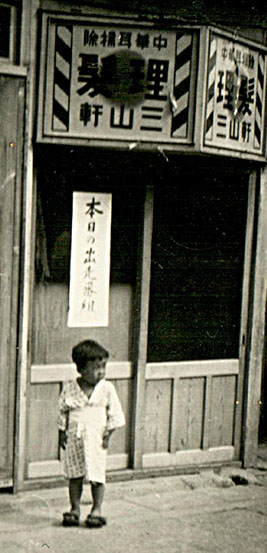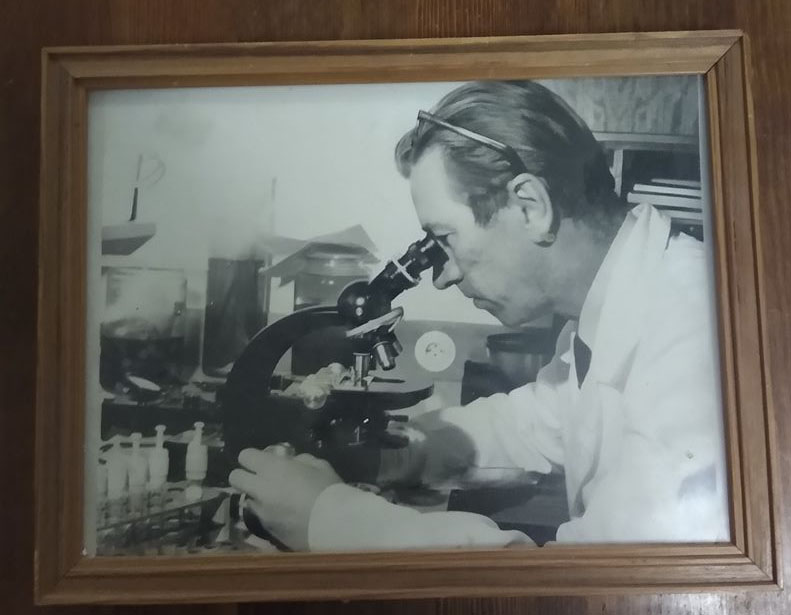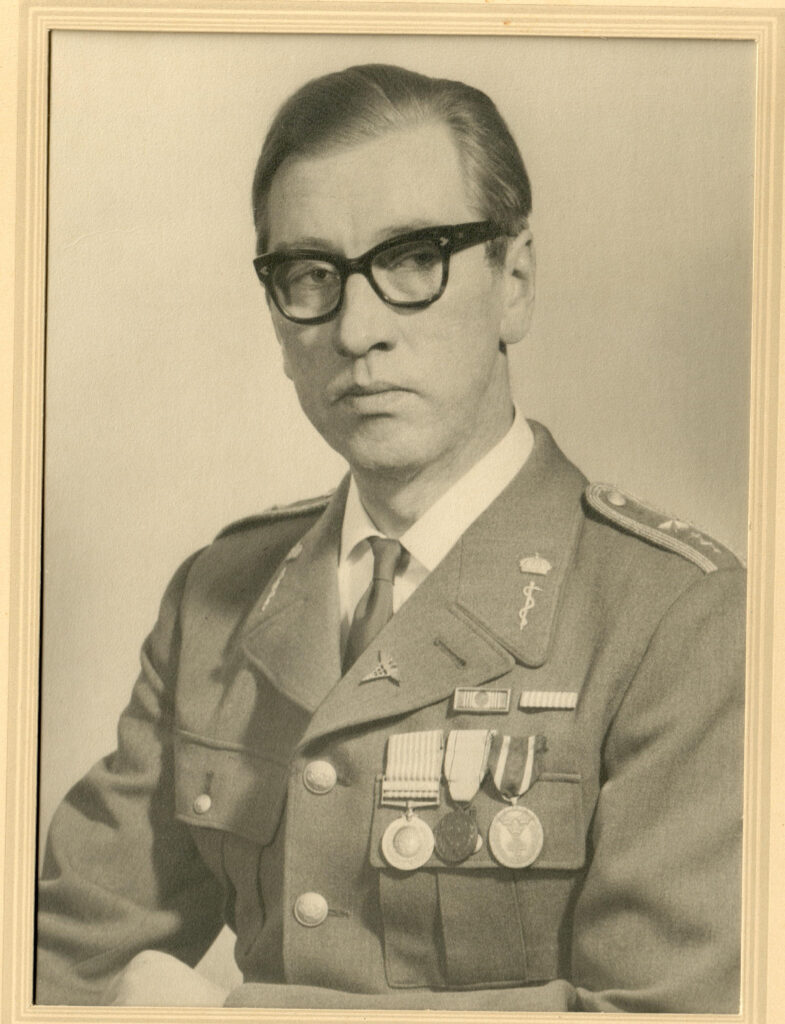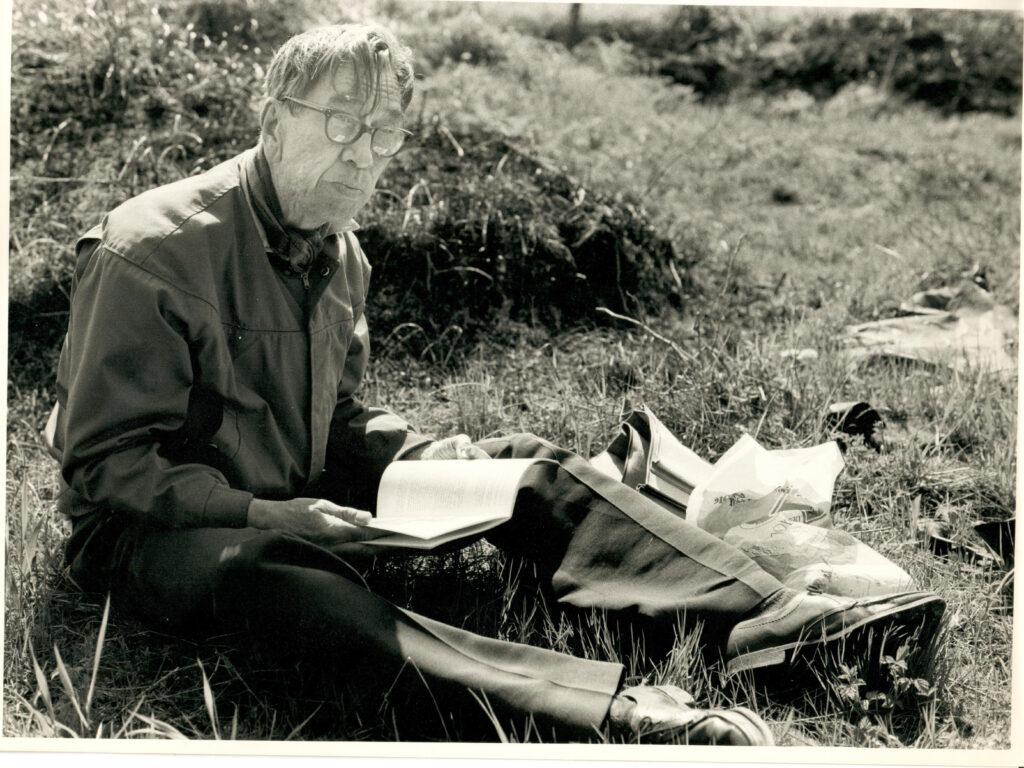I’m the son of a Korean war veteran, and I am searching for an unknown half sibling who was born in Korea. It was most likely a boy (see below).
Update March 19: KBS 2 (a major TV station in Korea) has described my search: https://youtu.be/Ur_HdeEWr5k.
Update March 19: The Swedish Korean Veterans’ Association supports me in my search, and will help me get in touch with some hospital veterans that are still alive.
.
My late father Olof “Olle” Henschen-Nyman served in the Swedish Red Cross field Hospital (known as SRCH) in Busan during the Korean War, and he had a child in Korea. I’m trying to find this unknown half-brother of mine.
My half-brother should be about 68 years old by now (born in 1952) and might have children (perhaps even grandchildren). If possible, I would also like to get in touch with the mother of my half-brother (if she is still alive) and her family.
Below is a picture from my father’s belongings, showing a small child outside a barbershop. The sign outside the barbershop is in Japanese.
The hairstyle shows that it is a boy.
I have received the following excellent translation and explanation from Young Lee (Seoul): “The Chinese character in the Barbershop sign suggests;
It’s “barbershop with ear cleaning service” (until recently in Korea). The store name of the barbershop is “Samsanheon”. “Samsan” is a area-related. “Heon” means house. “Samsan” is an area of Ulsan close to Busan. The shop was in “Samsan” area or the owner of the shop was from “Samsan”. The vertically written above the boy (it looks like a boy) means “Today’s runner (i.e. horse racing)”. It might mean the barbershop provide information or sell the racing game ticket. If the photographer knew that meaning, he pictured the children with that sign with some intention.
Two top characters in the vertical sign are Chinese and mean ‘today’ which is used in China and Japan, currently not in Korea.The third character is in Japanese and means ‘of’. So the top three characters mean ‘Today’s’.By the way, if the two characters were reversed, it means “Janpan”.The 4th and 5th characters are Chinese and mean ‘to run” or ‘running’ or ‘runner’.The 6th and 7th characters are Chinese and mean ‘list’ or ‘table’ as in TV Guide.The Chinese and Japanese sign was made before 1945 under Japanese rule and might be used without change until 1952.
Around 1952, it is highly probable that people in Busan and Ulsan area listened to Japanese radio broadcast including horse races.Until 1980’s when color TVs and sports broadcasting introduced in Korea, people in that area used to lisnten and watch Japanese radio and TV programs. The barbershop might have a radio which was a rare item in those years and provided the broadcasting for the guests.
In the top square barbershop sign, the first horizontal line means ‘Chinese-style ear cleaning’ or ear plug cleaning which is one of usual services in Korean barbershops until few years ago but is still available upon request nowadays.The second line means ‘hair cut’ and the oval in the background is Japanese flag.The third line in Chinese reads “Samsan-heon”. Samsan means three mountains. You can try googling for Samsan, Ulsan. Thear are many “Samsan” in Korean geographical naming but the famous “Samsan” close to Busan is located in the current Ulsan area.Ulsan belonged to the same “Gyeongsang” or ” Gyeongsangdo” province and was not well known until 1980’s when shipbuilding started.
The boy’s clothes looks like a sort of Japanese-style goun if it is one-piece. If it is two piece, Korean-style. It is very hard to tell from the photo.

It is possible that the mother belonged to the Japanese minority in Korea. However, I do not believe that the child was born in Japan. My father went back to Korea to accept the paternity, and told someone in Sweden years later that “I have a child in Korea”.
I don’t know the name of the mother of the child, but she obviously knew that it was my father who was the father of this child.
He knew as well, otherwise he would never have returned to Korea to acknowledge his paternity. It would not surprise me if she worked in the barbershop which is shown in the picture.
A search in the Red Cross archives in Sweden informed me that my father started working in the hospital on July 30, 1951. He worked as a doctor. At the time he was 36 years old. He was Swedish. His id number was 456, and his tour lasted four months. He was in charge of one department in the hospital (“Internal medicine”, most likely covering everything except surgery), and he was a medical doctor (MD) in internal medicine. In spite of being a doctor who never carried a gun, he did have a military grade of major (promoted to colonel when he ended his service).
He returned to Korea to acknowledge his fatherhood of the child. That would have been in 1952 or later. His name must have been registered. It is likely that the spelling in Korean was 우레 헨젠 녜만, 우레 헨젠 네만 or 우래 핸잰 네만. Olle (우레) was his given name, and Henschen-Nyman (헨젠 녜만) was his family name. At times he called himself “Olof Nyman”. If his title is mentioned in any record, it would probably be both MD and colonel.
This second trip to Korea was purely personal, he did not do a second tour at the hospital. He probably lived with the mother of the child during this second stay. When he returned to Sweden, he was emaciated and needed to use a neck brace. One of my sisters has heard that “he didn’t agree with the food”, but there might have been other reasons. He was very fit and did not normally have that kind of health problems.
I don’t know how long this second stay was or when it took place (it might have been two or three years after the child was born). He was married in Sweden during his service in Korea and his wife complained that he went to Korea “incessantly”, which indicates that he went back there as early as 1952. He never told me about this child, but he did tell someone about 15 years after returning that “I have a child in Korea”. I believe that he lost touch with the mother and child at some point after his second trip to Korea.
I do not know if he paid any kind of child support. Naturally, I hope that he did, but at present I have no way of knowing. With luck, I will find a way to trace any such payments. I heard about this by chance just before Christmas 2019. My father is gone now and so far, I haven’t found anyone who has been able to tell me more about this or who the mother might have been.
It is my understanding that most children with a Korean mother and a Western father were put up for adoption, often ending up in the USA or Western Europe. It is likely that this is what happened in this case. It’s almost certain that this child was born in 1952. Since he said years later “I have a child in Korea”, he didn’t know about any adoption.
The child might have ended up in an orphanage. Some children were left to be “discovered” and taken to an orphanage, and thus neither the mother, the father or even the date of birth were known. There is also a possibility that the child was not adopted. The child might even have been born in the same hospital (some women did give birth at that hospital, even though there wasn’t a regular maternity ward).
Any help would be appreciated, for instance suggestions about whom to contact. If someone sends me a promising document in Korean, I’ll look for a translator. I have started taking lessons in Korean.
I’ve received my DNA results from Ancestry and 23andMe, and uploaded them to FTDNA, 325Kamra (a DNA service for Korean adoptees and war veterans), MyHeritage, Gedmatch, Geneanet, LivingDNA and WeGene. No relevant results so far. My two half-sisters have also received their DNA results (still no relevant results). I’ve been informed that I’m not eligible to have my DNA entered into the “Missing persons” DNA database in Korea since I’m not Korean or a Korean adoptee. As far as I’m aware, there is nothing more that I can do concerning DNA, except to wait and hope that my half sibling (or a child/grandchild of the half sibling) takes a DNA test.
Our half-brother is likely to have DNA results indicating roughly the following ethnicity: Korean 50%, Swedish/Norwegian 35%, Finnish 15% (most likely the region Ostrobothnia) and a bit of French/German or Eastern European. Some traits that might have been passed on genetically: My father was tall, slim, and had brown hair. He had inclinations towards music, languages, and intellectual pursuits in general.
I’ve posted in various Facebook groups and started a Facebook group specifically for non-adoptees searching for their half siblings, ‘Searching for adopted “half” Koreans, Vietnamese, Laotians and Cambodians‘ (there are similar cases from the Vietnam War).
Known facts (so far) about my half-brother:
Born in 1952 (most likely in April-July)
Place of birth: Most likely Busan, quite possibly at the Swedish Red Cross field Hospital SRCH
Gender: male (very likely, based on the hairstyle)
Name of the father: Olle Henschen-Nyman (see above for possible ways of writing it in Korean)
Father’s date of birth: April 25, 1915
Title of father: Colonel (in the Swedish armed forces), medical doctor (MD)
Nationality of father: Swedish
Name of the mother: unknown
Title/occupation of mother: unknown, she might have worked in a barbershop
Nationality of mother: most likely Korean (possibly Japanese or Japanese-Korean)
My contact details: Erik Geijer, erik@tydligare.se, Huddinge, Sweden
제이복형제남매를찾습니다
지금까지 제가 알고있는 제 이복형제에 대한 정보
1952년생 (4월~7월생 추정)
출생지: 부산 스웨덴적십자협회 야전병원 추정
성별:남성
아버지 성함: 우레 헨젠 네만 (위 글에 다양한 한글 표기법으로 적어놓았습니다.)
아버지 생년월일: 1915년 4월 25일
아버지 직함: 스웨덴 대령, 의학박사(의사)
아버지 국적: 스웨덴
어머니 성함: 모름어머니 직업: 이발소 근무 추정 중이나 정확히 모름
어머니 국적: 아마도 한국인일 것이나, 일본인일 수도 있음
제 이름은 에릭 Erik Geijer이며
이메일 주소는 erik@tydligare.se 이고
스웨덴 Huddinge에 살고 있습니다.
(Translation by Suyeon Khimm)
Article from Busan Namgu:
저는 한국전쟁 때 부산의 스웨덴적십자야전병원(서전병원)에 근무했던 어느 스웨덴 참전용 사의 아들입니다. 저는 70년 만에 존재를 알게 된 본적도 들은 적도 없는, 부산에서 태어난 것으로 추정되는 이복형제를 찾고 있습니다.
제 아버지의 이름은 우레 헨젠 네만(Olle Henschen-Nyman)입니다. 당시 정확한 한글 표 기를 몰라 `우레 헨젠 녜만’ 혹은 `우래 핸잰 네만’으로도 불렸을 수 있습니다. 아버지는 ” 한국에 너의 이복형제가 있다”는 짧은 유언을 남기고 운명하였습니다. 더 이상의 말씀이 없 어 남자 형제인지 여자 형제인지도 알 길이 없습니다.
스웨덴의 적십자 기록보관소에서 자료를 찾아보니 아버지는 1951년 7월 30일부터 4개월 간 부산 스웨덴적십자야전병원에서 의사로 일하였습니다. 당시 36세였고 ID번호(군번)는 456이었습니다. 아버지는 서전병원의 한 부서(수술을 제외한 모든 것을 다뤘을 가능성이 높 습니다)를 담당했으며 내과 의사(의학박사)였습니다. 군인이 아닌 의사였음에도 대령 계급으 로 근무하였습니다.
당시 서전병원 직원들은 병원 밖을 함부로 나갈 수 없었기 때문에 아버지가 다른 곳에 사 는 여성을 만났을 가능성은 적습니다. 이런 여건을 고려해 보건대 그 여성은 서전병원에서 일을 한 것 같고 당시 스웨덴 의료진을 보조하던 한국인 간호사가 아니었을까 추측됩니다. 물론 서양여성이었거나 당시 유엔군들이 유흥을 위해 찾던 `캠프타운’에서 일한 여성일 수 도 있습니다. 여하튼, 아버지는 그 이복형제가 자신의 아이임을 알 정도로 그 여성과 동거 관계 혹은 꽤 진지하고 지속적인 관계였던 것으로 보입니다.
아버지는 이복형제에 대해 어떠한 말씀을 한 적은 없는데, 한국에서 돌아온 지 15년쯤 되 던 해에 “한국에 내 아이가 있다”고 누군가에게 털어놓았습니다. 저는 2019년 성탄절 직전 에 우연히 이복형제의 존재에 대해 알게 되었습니다. 그 후 이복형제에 대해 정보를 줄 어 떠한 사람도 만나지 못하고 있습니다. 한국 근무 기간에 아버지는 스웨덴에서 이미 결혼을 했었습니다. 당시에는 한국인 어머니와 서양인 아버지 사이에서 태어난 혼혈 아기들이 더러 미국이나 서유럽으로 입양되었던 걸로 알고 있습니다. 저의 이복형제도 그렇게 됐을 가능성 이 없지 않습니다.
아이는 1952년에 태어났음이 확실합니다. 그 아이가 고아원에 보내졌다면 엄마, 아빠 심 지어 출생일도 알 수 없을 겁니다. 물론 입양이 되지 않았을 수도 있습니다. 그런 상황에서 임신 한 간호사는 보통의 다른 많은 한국인 미혼모보다는 상황이 좀 더 나았을 겁니다. 비 록 당시 서전병원에 산부인과 병동은 없었지만 일부 여성들의 출산을 도왔기에 어쩌면 그 아이는 서전병원에서 태어났을 수도 있습니다.
아버지는 자신의 혈육인 그 아이를 보기 위해 한국으로 다시 돌아간 적이 있었습니다. 1952년이나 어쩌면 이복형제가 태어나고 몇 년이 흘렀을 수도 있습니다. 그때 한국행은 서 전병원과는 무관한 지극히 개인적인 방문이었습니다. 아마도 체류 기간 동안 아버지는 아이 의 어머니와 함께 지냈을 겁니다. 아버지는 매우 건강했는데 두 번째 한국을 다녀온 뒤 몸 이 쇠약해져 목보조기를 사용해야 했는데 누나 중 한 명이 “아빠가 한국 음식과 안 맞았다” 고 한 말을 기억하고 있습니다.
저는 유전자 분석회사인 23andMe사로부터 DNA 검사를 받아 그 결과를 미국 DNA 검사 기관인 FTDNA(Family Tree DNA)와 한국계 혼혈 입양인들이 설립한 비영리단체 325KAMRA에도 올렸습니다. 저는 이복형제를 찾기 위해 페이스북(www. facebook.com/erik.geijer.79)도 개설하였습니다. 제가 찾는 이복형제의 DNA는 아마도 한 국인 50%, 스웨덴·노르웨이인 35%, 핀란드인 15%의 특성을 가지고 있을 겁니다. 일부 프 랑스인이나 독일인, 동유럽인들의 특징도 유전되었을 수 있습니다. 아버지는 키가 크고 날 씬했으며 갈색 머리에 음악과 언어, 지적인 성향이 있었습니다.
그 아이가 살아있다면 현재 68세일 테고 자녀나 손주가 있을 수도 있습니다. 저는 이복형 제와 그의 자녀들 심지어 생존해 계시다면 이복형제의 모친과도 기꺼이 연락을 하고 싶습니 다. 저의 이름은 에릭 에이예르(Erik Geijer)이며 직업은 영어-스웨덴어 공인번역가입니다. 그 누구라도 저의 이복형제와 관련해 어떠한 정보라도 줄 수 있다면 감사하겠습니다. 한국 어로 이메일(erik@tydligare.se)을 보내주시면 번역가를 찾아 한글로 번역을 하겠습니다.
저는 한국어 공부도 시작했습니다.
사진설명:
우레 헨젠 네만 씨의 1951년 부산 스웨덴적십자야전병원(서전병원) 근무 당시의 모습. 에릭 에이예르 씨의 이복형제로 추정되는 어린이 사진.
- 인물 정리
△이복형제:1952년 4~7월 부산 혹은 서전병원에서 출생했을 가능성, 성별 모름.
△이복형제의 모친:서전병원에 근무한 한국인 간호사나 보조의료진일 가능성 높음.
△아버지 우레 헨젠 네만(Olle Henschen-Nyman):1915년 4월 25일 출생한 스웨덴인. 한국 전쟁 당시 1951년 7월 30일부터 4개월간 부산 스웨덴병원에서 내과의사(의학박사·대령 계 급)로 근무.
△연락처:erik@tydligare.se 한국어로 메일을 보내면 한국어 번역 가능
△에릭 예이예르 씨는 이복형제에 관한 정보와 사진을 담은 개인 인터넷 페이지를 최근 개 설해 공개했다. http://searchingforakoreanhalfsibling.se




There is a picture in my father’s belongings, showing a small child outside a barbershop. The child is wearing Japanese clothes and the sign outside the barbershop is in Japanese. The text in the sign has been translated (not by me) to “Japan” or “Japanese Colonial Period” (1909-1945), “Zhonghua, Haircut, Samsanheon”, “Today’s Program”.oök.mm,.m,nm,,.mm,.m,